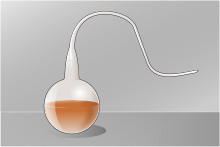This is an old revision of this page, as edited by Magneticstockbrokingpetdetective (talk | contribs) at 19:59, 6 January 2009. The present address (URL) is a permanent link to this revision, which may differ significantly from the current revision.
Revision as of 19:59, 6 January 2009 by Magneticstockbrokingpetdetective (talk | contribs)(diff) ← Previous revision | Latest revision (diff) | Newer revision → (diff)Spontaneous generation is an obsolete theory regarding the origin of life from inanimate matter, which held that this process was a commonplace and everyday occurrence. It is generally accepted to have been ultimately disproven in the 19th Century by the experiments of Louis Pasteur, expanding upon the experiments of other scientists before him. Ultimately, it was succeeded by germ theory and cell theory.
The disproof of ongoing spontaneous generation is no longer controversial, now that the life cycles of maggots and other pests have been well documented. However, the question of abiogenesis, how living things originally arose from non-living material, remains relevant today.
Scientific method

Ancient beliefs were subjected to testing. Francesco Redi challenged the idea that maggots arose spontaneously from rotting meat. In the first major experiment to challenge spontaneous generation, he placed meat in a variety of sealed, open, and partially covered containers. Realizing that the sealed containers were deprived of air, he used "fine Naples veil", and observed no worm on the meat, but they appeared on the cloth.
In 1745, John Needham performed a series of experiments on boiled broths. Believing that boiling would kill all living things, he showed that when sealed right after boiling, the broths would cloud, allowing the belief in spontaneous generation to persist.
Lazarro Spallanzani modified the Needham experiment in 1768, attempting to exclude the possibility of introducing a contaminating factor between boiling and sealing. His technique involved boiling the broth in a sealed container with the air partially evacuated to prevent explosions. Although he did not see growth, the exclusion of air left the question of whether air was an essential factor in spontaneous generation.
In 1837, Charles Cagniard de la Tour, a physicist, and Theodor Schwann, one of the founders of cell theory published their independent discovery of yeast in alcoholic fermentation, in studies using the microscope.
Louis Pasteur's 1859 experiment put the question to rest. He boiled a meat broth in a flask that had a long neck which was bent to prevent any particles from falling in. The flask remained free of growth for an extended period. When the flask was turned so that particles could fall down the bends, the broth became clouded, quickly.
References
- ^ Russell Levine (1999). "The Slow Death of Spontaneous Generation (1668-1859)". Washington, D.C.: National Health Museum. Retrieved 2008-12-19.
{{cite web}}: Unknown parameter|coauthors=ignored (|author=suggested) (help) - Francesco Redi of Arezzo (1909) . Mab Bigelow (translator) (ed.). Experiments on the Generation of Insects. Chicago: Open Court. Retrieved 2008-12-19.
{{cite book}}:|editor=has generic name (help)